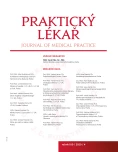Risk objects and surfaces in terms of transmission of infections in the provision of health care
Authors:
M. Krause 1,2; F. Dolák 1
Authors‘ workplace:
Jihočeská univerzita v Českých Budějovicích, Zdravotně sociální fakulta, Ústav ošetřovatelství, porodní asistence a neodkladné péče, Ředitelka: prof. PhDr. Valérie Tóthová, Ph. D.
1; Technická univerzita v Liberci, Fakulta zdravotnických studií, Ústav ošetřovatelství a neodkladné péče, Děkan: prof. MUDr. Karel Cvachovec, CSc., MBA
2
Published in:
Prakt. Lék. 2020; 100(4): 203-206
Category:
Of different specialties
Overview
Aim: The aim of the research was to identify non-critical high touch risk objects and surfaces used in the provision of nursing care in hospital conditions at standard internal and surgical departments.
Methods: Qualitative research using the technique of unstructured observation. The realization of research took place in a regional-type hospital and data collection was completed after reaching theoretical saturation. The analysis was performed by the method of open coding using the pen and paper technique.
Results: The research identified non-critical high touch objects, namely medical devices, administrative objects, containers for carrying and storing objects and medical materials and other packaging. Furthermore, objects used to administer drugs, ensure patient self-sufficiency, hygienic care, emptying and collection of biological material. Furthermore, non-critical high touch surfaces were identified, namely work trays, trolleys, work surfaces for the preparation of injection and infusion therapy, lids, storage areas and the hospital bed, including accessories.
Conclusion: Healthcare associated infections are an actual problem with regard to the possibility of transmission of pathogens through objects and areas used in the provision of health care, including nursing care. For the transmission of healthcare associated infections through objects and surfaces, their identification and following effective decontamination is important.
Keywords:
Decontamination – healthcare associated infections – Disinfection – high touch objects and surfaces – microorganisms
Sources
1. Evropská komise. Politiky Evropské unie: Veřejné zdraví. Lucemburk: Úřad pro publikace Evropské unie, 2014.
2. Gonçalves L, Miñán AG, Benítez GA, et al. Self-sterilizing ormosils surfaces based on photo-synthesized silver nanoparticles. Colloids Surf B Biointerfaces 2018; 164(1): 144–154.
3. Gonzalez E, Nandy P, Lucas AD, Hitchins VM. Ability of cleaning-disinfecting wipes to remove bacteria from medical device surfaces. Am J Infect Control 2015; 43(12): 1331–1335.
4. Haque M, Sartelli M, McKimm J, Abu Bakar M. Health care-associated infections – an overview. Infect Drug Resist 2018; 11 : 2321–2333.
5. Hasan J, Chatterjee K. Recent advances in engineering topography mediated antibacterial surfaces. Nanoscale 2015; 7 : 15568–15575.
6. Khan A, Ahmad A, Mehboob R. Nosocomial infections and their control strategies. Asian Pac J Trop Biomed 2015; 5(7): 509–514.
7. Kumar S, Sen P, Gaind R, et al. Prospective surveillance of device-associated health care–associated infection in an intensive care unit of a tertiary care hospital in New Delhi, India. Am J Infect Control 2018; 46(2): 202–206.
8. NHMRC. Australian guidelines for the prevention and control of infection in healthcare. Canberra: National Health and Medical Research Council 2019 [online]. Dostupné z: www.nhmrc.gov.au/file/14936/download?token=beROLljD [cit. 2020-05-25].
9. Russotto V, Cortegiani A, Raineri SM, Giarratano A. Bacterial contamination of inanimate surfaces and equipment in the intensive care unit. J Intensive Care 2015; 3 : 54.
10. Sattar S. Cleaning, disinfection, and sterilisation. Portadown: International Federation of Infection Control 2016 [online]. Dostupné z: https://www.theific.org/wp-content/uploads/2016/04/12-Cleaning_2016.pdf [cit. 2020-05-25].
11. Sattar SA, Bradley C, Kibbee R, et al. Disinfectant wipes are appropriate to control microbial bioburden from surfaces: use of a new ASTM Standard Test Protocol to demonstrate efficacy. J Hosp Infection 2015; 91(4): 319–325.
12. Schmidt MG, von Dessauer B, Benavente C, et al. Copper surfaces are associated with significantly lower concentrations of bacteria on selected surfaces within a pediatric intensive care unit. Am J Infect Control 2016; 44(2): 203–209.
13. Suleyman G, Alangaden G, Bardossy A. The role of environmental contamination in the transmission of nosocomial pathogens and healthcare-associated infections. Curr Infect Dis Rep 2018; 20(6): 12.
14. WHO. Decontamination and reprocessing of medical devices for health-care facilities. Geneva: World Health Organization 2016.
15. WHO. Global guidelines for the prevention of surgical site infection. Geneva: World Health Organization 2018.
16. WHO. Patient safety: making health care safer. Geneva: World Health Organization 2017.
Labels
General practitioner for children and adolescents General practitioner for adultsArticle was published in
General Practitioner

2020 Issue 4
Most read in this issue
- Manifestations of infectious diseases in the oral cavity
- ERAS concept and its contribution to intensive care
- Laryngocele – current view of the issue
- Two current pandemics: obesity and COVID-19
